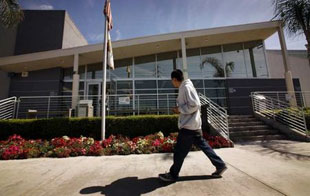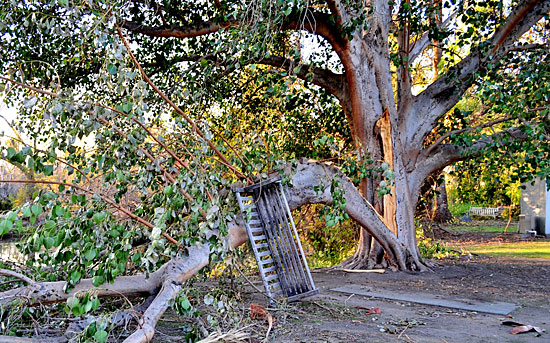Ice skating picks up speed in L.A.
December 13, 2011
Edward Thomen works in a downtown L.A. law office, but on a recent lunch hour, he was more about the blades than the briefs.
He glided expertly around the ice rink at Pershing Square like a figure out of a Currier & Ives print—if Currier & Ives traded in their winter scarves for some palm trees and sunscreen.
These are glory days for the outdoor L.A. ice skater.
With a proliferation of seasonal outdoor rinks freezing up all over town, Angelenos are making a bid to knock their East Coast counterparts off their winter skating pedestal. Or at least make them envy our average December high of 68 degrees.
Thomen, out on the ice in his office wear of slacks and button-down shirt, said it’s a far cry from the indoor rinks where he skated when he first started playing ice hockey with Southern California friends 24 years ago.
“We never skated outdoors,” said Thomen, 53, who tried the city-sponsored “Downtown on Ice” at Pershing Square for the first time last year. “It’s great—you’re not under fluorescent lights and it’s not freezing cold.”
So how did a town better known for rollerblades than ice skates get all warm and fuzzy about winter rinks? As always, look for the showbiz angle.
Olympic skater-turned-event-producer Willy Bietak said the technology used in the Ice Capades made it possible to bring outdoor ice rinks to warmer climes.
Specialized cold-and-heat-conducting aluminum panels were developed so the show could set up and tear down in short order as it moved between cities, he said. In 1995, that technology was adapted for an outdoor public rink in San Francisco. The rest, he said, is ice skating history. “There are rinks everywhere now,” Bietak said.
As a result, even L.A. natives who’ve never seen snow before are giving ice skating a whirl, sometimes looking a bit like wobbly newborn deer testing out new legs.
“I think it is a novelty,” said Terri Berman, a spokeswoman for L.A. Kings Holiday Ice at L.A. Live. “We have seen more and more people who have never skated before, and they bring the whole family—parents, kids, even grandparents.”
She said attendance so far this season is up 17% compared to last year.
Cost varies from rink to rink. The city-run “Downtown on Ice” in Pershing Square is a relative bargain, charging $6 plus $2 for rentals, and showing a Metro pass saves an additional dollar. The venue also provides added entertainment including lunchtime and evening concerts and a free Winter Holiday Festival on Saturday, December 10, featuring Santa, children’s crafts, puppet shows and a snow play area.
Options for outdoor skating beyond downtown include ICE in Santa Monica and Woodland Hills Ice. Don’t forget the sunscreen.
Posted 12/7/11
These photos are surreal
December 13, 2011

Pierre Beteille's "Me, me, me, me, me...and me!" is among works on display at Annenberg Space for Photography.
Salvador Dalí never had it so good.
A year after the legendary surrealist’s death, Adobe Photoshop came along and revolutionized artists’ ability to transform images with computers. Starting this Saturday, some of the mind-bending results made possible by the new technology will be displayed in Century City.
Digital Darkroom, an Exploration of Altered Realities, is the Annenberg Space for Photography’s latest free exhibition. Created with guidance from Russell Brown, an original designer of Photoshop, it features 80 printed works from 17 modern image-smiths. Hundreds of additional images will be displayed on two 14’ by 7’ high-resolution screens.
The museum will also screen a 3D short film on the artists’ works and creative process.
The nonprofit Annenberg Space for Photography presents all kinds of photography, from traditional to modern. Billing itself as the “first solely photographic cultural destination in the Los Angeles area,” even its unique architecture mimics a camera and lens.
Digital Darkroom opens to the public Saturday, December 17, and runs through May 28, 2012, open Wednesdays through Sundays. Visit the website for hours and directions.
Posted 12/12/11
Make it a pet-safe holiday
December 12, 2011

Even if holiday pet costumes are irresistible, many other trappings of the season can be hazardous to pets.
For pets and people alike, a bit of holiday chaos is par for the course this time of year. The Los Angeles County Department of Animal Care and Control has some advice to help keep furry companions safe in the midst of all the festivities.
First, food that’s fine for the two-legged can be hazardous to the four-legged. Chocolate is poison for dogs and cats, turkey bones can splinter and cause injury, and alcoholic beverages really do a number on an 8-pound terrier (or any pet, for that matter).
Festive decorations also can be deadly. Poinsettias, English holly, Christmas berry, Christmas rose and mistletoe are poisonous to dogs and cats. Liquid preservatives used to keep Christmas trees fresh can also be dangerous, and electrical wiring, shiny ornaments and gift wrapping could be chewed or swallowed, causing injury.
It’s recommended that you keep all these items out of Fido’s reach, and encourage friends and family to do the same. Taking a few moments to pet-proof your home will help animals avoid most of the hazards of the season—with the possible exception of dog-sized reindeer antlers and Santa hats.
Posted 12/12/11
Channeling the divine seas
December 12, 2011

"Rainbow Serpent" by Jose Ponce is one of the artworks on display at the Santa Monica Pier Aquarium.
Exhibits at Heal the Bay’s Santa Monica Pier Aquarium are typically educational, conservation-minded and fun. Now, you can add “historical, mythological and artistic” to the mix as the aquarium partners with Otis College of Art and Design on a new show.
“The Divine Seas” presents sea creatures from ancient and modern times, as illustrated by Otis students. The exhibit attempts to show how our modern, often-impersonal relationship with the ocean contrasts with traditional cultures that viewed the sea as full of supernatural life and mystery.
The illustrations will be displayed through the end of December. Admission is free to children under 12, and a suggested donation of $5 is requested from everyone else. The aquarium is located at the beach level of the Santa Monica Pier, 1600 Ocean Front Walk.
Posted 12/12/11
Weighing the costs of recovery [updated]
December 7, 2011
During the past 18 months, Los Angeles County public health officials have quietly opened a new—and controversial—front in their battle against the painful and costly cycle of addiction, treatment and relapse.
Under a little known pilot project, some 600 uninsured individuals have received roughly 1,500 injections of the drug Vivitrol, which has shown promising results in reducing cravings while allowing the benefits of traditional recovery to take a stronger hold. The publicly-funded project is said to be the largest of its kind in the nation.
Now the Department of Public Health hopes the Board of Supervisors will, in the coming days, approve a request for $3.4 million to expand the delivery of Vivitrol in an even broader effort to determine whether the $847-per-dose injections improve the odds of long-term sobriety—and can do so at a lower overall cost to the public. [See update below.]
“This breaks new ground for the county,” says John Viernes, director of the Department of Public Health’s Substance Abuse Prevention and Control Division. “Many clients, even on a court order, will leave residential treatment after only a few days because the urge to use is so great. If we can get people into recovery faster and decrease relapses, we can serve more people. The whole cycle changes, both in terms of productivity and quality of life.”
The stakes are high: In Los Angeles County, the economic costs of alcohol-related illnesses, injuries, traffic accidents and crime approach $11 billion annually. The Department of Public Health alone spends more than $200 million on substance abuse and prevention programs each year.
Although the drug’s price also is high, Viernes insists it can be lowered through bulk purchase. “The initial cost is high for any new strategy,” he says.
Vivitrol, an extended-release formulation of the anti-addiction drug naltrexone, was approved for the treatment of alcohol dependency in 2006 by the federal Food and Drug Administration. Injected monthly, Vivitrol has been used for several years in private rehabilitation clinics. Last year, it also was approved to assist opiate users in relapse prevention.
Clinicians say the drug helps clients—particularly those with a family history of alcoholism—stay sober long enough to focus on a course of therapy or 12-step program, which is key because studies have shown that long-term recovery rates improve the longer an alcoholic or drug addict remains in treatment.
It’s not a magic bullet,” says Ken Bachrach, Ph.D., psychologist and clinical director at Tarzana Treatment Centers, one of the providers that has participated in the county pilot program. “I view it more as value-added. But if we can get [clients] past six months, they have a much better chance of staying clean.”
Aside from complaints about its administration (a hip injection), the shot’s most common side effects are occasional nausea, headaches or fatigue. Numerous studies have found that recovering alcoholics who combine Vivitrol with counseling tend to stay sober longer, drink less if they relapse and return more quickly to treatment.
Studies done by two insurance providers—Horizon Blue Cross Blue Shield of New Jersey and Aetna Behavioral Health Care—also showed that the drug dramatically reduced the hospitalization, pharmacy and medical costs of treating the alcohol-dependent.
The Horizon study, which examined the medical bills of recovering alcoholics for 30 months after Vivitrol injections, found that alcohol-related hospital costs fell 52 percent, total medical costs fell 34 percent and combined medical and pharmacy costs fell 49 percent. Among those requiring the most care prior to their treatment, Vivitrol injections cut medical costs by some $70,000 per patient a year.
But the drug has been slow to catch on, partly because of the cost of the injections and partly because clinicians and alcohol counselors traditionally have been more accustomed to treating substance dependencies with behavior modification therapy and oral drugs, if they use any medication at all. Also, many substance abuse programs lack the necessary staffing and clinical licenses to administer injections, so the patient often has to go to a doctor’s office each month to get the shot.

Tarzana Treatment Center is among the rehab facilities where the county is testing Vivitrol. Photo/Los Angeles Times
Under the county’s pilot project, the drug has been administered during the past 18 months to uninsured clients in various county-funded recovery programs, ranging from people in court-ordered treatment to homeless indigents, says Viernes.
Those county clients have each received between one and four shots since March 2010 as part of their treatment, Viernes says. So far, he says, both inpatient and outpatient clients who’ve been given at least one dose of the drug have been up to twice as likely to complete treatment as those who have not received injections.
One client, a 45-year-old woman who had endured “over 20 detoxes”, reported that, thanks to Vivitrol, her cravings for alcohol had stopped for the first time since her adolescence. A 52-year-old man, who’d been in and out of 12-step programs since his twenties, reported that after two shots, he could focus on his recovery for the first time—and pass a liquor store without realizing it.
Still, despite such testimonials, UCLA researchers have not been tracking clients long enough to determine the medication’s possible benefits for long-term sobriety. Nor is it clear how long an alcoholic or addict might need the injections. The drug’s manufacturer, Alkermes, recommends 6 months to a year of treatment, although county has tried to maintain a 3-shot limit in its pilot program.
Viernes says most of the county clients required only one or two shots to help them focus better on the other aspects of their treatment. But each case is different. At least one participant cited in a preliminary evaluation of the pilot—a 36-year-old blackout drinker and methamphetamine user with a 20-year habit—was on his fourth injection, possibly because of his dual addiction.
“When they’re done with the Vivitrol, what happens? In the next phase, we’re hoping to find that out,” explains Desiree Crevecoeur-MacPhail of the UCLA Integrated Substance Abuse Programs, which is conducting the evaluation.
“Medically assisted” treatments like the county’s pilot project are part of a relatively recent trend in substance abuse research. While many addicts swear by counseling and 12-step programs, few manage to avoid relapses along the way, and even the best-regarded recovery programs are not immune to this reality.
At the same time, however, counselors familiar with the so-called “psycho-social model” of treatment have been slow to incorporate pharmacology into their 12-step and behavioral therapy programs, either because of a reluctance to treat addicts with more drugs or because of the psychological underpinnings of addiction.
In fact, an earlier attempt to incorporate Vivitrol into county treatment programs three years ago fizzled in part because counselors were skeptical, Viernes says.
“There was an aversion to using medication as a means of recovery,” he says, adding that this attitude has softened as medically assisted treatment has become more common.
“Now that we’ve seen its efficacy,” Viernes says, “we’ve reached a tipping point where the clients are coming to us for the injections.” He says demand has risen so quickly that the county’s supply of the drug is nearly gone.
Public health officials say the Vivitrol project took shape after the drug’s manufacturer offered some free samples to Tarzana Treatment Centers, one of the county’s contracting agencies, in 2008.
At the time, Vivitrol had been on the market for only two years, but substance abuse workers were familiar with the generic form of naltrexone, which has been available in pill form since the mid-1990s. The pills had received mixed reviews because, while they cut cravings, they had to be taken daily and patients who skipped pills often relapsed.
The injections were designed to sidestep that problem by ensuring that a single dose would, at the very least, help the patient go 30 days without cravings.
“Alkermes donated 100 vials to Los Angeles County, and we did a small trial with about 32 patients,” says Jim Sorg, director of admissions at Tarzana Treatment Centers. Over six months, the Centers would later report, 23 moved on to residential treatment and only four quit against medical advice.
From there, Viernes says, the study gradually grew to include more than a dozen treatment providers, who refer clients to larger centers, such as Tarzana, for injections.
Expansion of the pilot, he says, will give the county three more years to find out whether medically assisted treatment will slow the revolving door of substance abuse treatment—and to decide whether it improves enough lives and cuts enough from the long-term costs of alcoholism to justify the public expense.
In the meantime, providers are hopeful.
“It’s not a guarantee,” says Bachrach of Tarzana Treatment Centers. “It’s more as if a doctor said, ‘I have something that’s not going to cure you, but will increase your chances of recovery.’ If we can give some extra help to people with addiction, why shouldn’t we?”
Posted 12/7/11
Updated 12/13/11: The Board of Supervisors agreed on Tuesday to broaden the use of the drug Vivitrol in county substance abuse treatment, but also asked the public health department to report back on both the long-term efficacy of the medication and how to lower its cost to the county.
Acting on Supervisor Yaroslavsky’s motion, the board agreed to three more years of funding at a little more than a million dollars annually for the innovative-but-expensive injections, which reduce cravings so that people addicted to alcohol and opiates can better focus on treatment.
“Simply put, this medication helps people stay in treatment longer, which is critical because studies have shown that long-term recovery rates improve the longer an alcoholic or drug user remains in treatment,” Yaroslavsky said.
But Yaroslavsky also wanted better information on the so-called “medication-assisted therapy” and on ways to reduce the $837-per-dose the county must pay for the drug.
The department was asked to report back in three months on bulk pricing and how to improve the likelihood of Medi-Cal reimbursement, as well as how to potentially incorporate Vivitrol into DUI programs.
A follow-up report in a year was also requested to look at medium- and long-term patient outcomes and to examine ways in which the shots—if they turn out to be worthwhile—might be expanded to high-risk populations, such as clients in drug court, probation programs and jail.
Not the ticket for fair play
December 7, 2011
On New Year’s Day, California will begin offering a gift of sorts to motorists across the state who’ve failed to pay a cent on traffic ticket fines and penalties that were due on or before January 1, 2009. Now, under a new law, they’ll have six months to pay just half of what they owe.
 In the legislature’s view, getting at least some money into the state’s depleted treasury is better than getting none. And for the offenders, well, the upside is obvious.
In the legislature’s view, getting at least some money into the state’s depleted treasury is better than getting none. And for the offenders, well, the upside is obvious.
But not everyone catches a break under the amnesty program, thanks to some wrongheaded rules concocted by the statewide Administrative Office of the Court. The AOC has determined that only people who’ve paid nothing on their tickets during the past two years are eligible for the 50% discount. This means that if you’ve sent along any money at all since 2009, then you’re excluded from the deal. In L.A. County, some 75,000 people fall into this category.
If you’re like me, you’re probably thinking: What? Why would we essentially penalize people who’ve made some good-faith efforts to pay their tickets while offering bargain rates to those who haven’t?
Actually, there’s no good reason.
The AOC is simply—and cynically—playing the odds. It apparently figures that anyone who’s made good on even a sliver of their debt is likely to keep paying. Conversely, those who’ve paid nothing will probably continue along that same course. This latter group, the thinking goes, needs special inducements.
But here’s the problem: it’s blatantly unfair. What’s more, there’s no place in the law that calls for this exclusion. In fact, the Los Angeles County Counsel and the counsel for the Los Angeles Superior Court have concluded that the AOC incorrectly incorporated an eligibility requirement not found within the four corners of the statute, SB 857.
Next Tuesday, the Board of Supervisors will consider a motion I’ve authored to reverse this inequity. I’ve asked my colleagues to join with me in sending a five-signature letter to the California Judicial Council, urging that the AOC be required to include in the amnesty program individuals who’ve made any payments towards fines incurred or due prior to January 1, 2009.
We need to send a clear message to court administrators that such fiscal gamesmanship—even in the service of a good cause—is unacceptable.
Posted 12/7/11
Arboretum torn from limb to limb
December 7, 2011

Winds split the limbs of this Bodhi tree and ripped a bench from its bolts. Photo by Frank McDonough
Call it triage—or maybe, more accurately, “tree-age.”
Clean up crews at the Los Angeles County Arboretum & Botanic Garden are just beginning to get a full sense of the destruction wreaked by last week’s raging windstorm. Home to some 10,000 species of plants, the 127-acre public garden in Arcadia lost hundreds of specimens, including a huge Bluegum eucalyptus planted in the 1880s.
“This is going to take weeks to assess—we still can’t get into some areas because we haven’t cleared them,” said Superintendent Tim Phillips. “We have a three-member curatorial team mapping the damage and they’ve been working until dark since Monday. And that’s just for the general overview.”
Philips said that although “entire collections have been severely damaged”—including the garden’s iconic Ear Pod trees—there also were some spirit-lifting surprises.
“We have a native population of Engelmann oaks, which are the most northerly stand inCalifornia. The winds came down right over them and they came out unscathed,” Philips said.
The once-perfectly manicured grounds, now coated with limbs, leaves and debris, remain closed to the public. Arboretum officials said it will take at least two weeks before a small section of the grounds can be reopened. They expect that the place won’t be restored entirely until next year. Progress updates will be posted on the arboretum’s website.
Arboretum officials are appealing for the public’s help in restoring the grounds through a fund-raising drive that represents “the single biggest tree planting campaign in the institution’s history.”
“The most important thing folks can do is to help us replant the Arboretum,” said Chief Executive Officer Richard Schulhof, who expects the initiative to run into the tens of thousands of dollars.
“Many of the trees we lost were planted 50 years ago at the time of our founding. Now we have to plant the next generation.”
Fortunately, he said, the storm arrived just as the Arboretum had completed a strategic plan to update and improve the gardens. Prior to last week, he said, there wasn’t much room for new installations.
Now, Schulhof said, the staff can increase the gardens’ focus on water conservation and gardening within the Southern California climate and maybe create new spaces featuring drought-resistant plants or lawn alternatives.
“It’s heartbreaking, but it’s also a godsend,” said botanical information consultant Frank McDonough, who has been photographing and helping inventory the damage. “This will allow us to curate more items, and curate with a policy that reflects the needs of L.A.” (Click here to see a gallery of McDonough’s pictures.)
McDonough said the windstorm was a reminder “that you don’t know what you have until it’s gone.”
CEO Schulhof agreed
“There was a pink trumpet tree that was in just the most ideal location,” he recalled sadly. “It created a perfect vista in one part of the Arboretum. It was one of my favorites, and that tree got knocked down.
“But there are many wonderful specimens that survived. I’m looking at one now, a Philippine species of eucalyptus. It’s probably the greatest specimen of its kind in California, and here it is, still standing. Tall and beautiful.”
Posted 12/7/11
Spot a pothole? Give it “The Works”
December 7, 2011
If you’ve ever wished you could zap a pothole or wipe out some graffiti, the county Department of Public Works has a message for you: the power’s in your hands.
Or, to be precise, on your iPhone.
The department’s new “The Works” app offers a point-and-shoot approach to cleaning up quality of life nuisances in county territory, including illegal dumping and street sweeping issues.
Once the free app is downloaded, you can use the camera on your iPhone to send Public Works an instant image of the problem, get a ticket number and keep tabs on how the issue is resolved. (It’s also possible to send a message about the problem without including a photo.) If the location is not within the county’s jurisdiction, the app detects that and directs the customer to the appropriate agency. Jesse Juarros, the department’s chief information officer, said the “end game” is eventually to get all cities within L.A.County to join up so that reports can be forwarded seamlessly to the right place.
Since it was launched Oct. 18, the app has been downloaded 700 times—with more than 330 service requests received, including referrals to other cities.
“Most of them are for potholes, as you’d expect,” Juarros said. “The other one that ranked up there was illegal dumping.”
The new app is “definitely” contributing to quicker graffiti removal, Juarros said, because notifications go directly to clean-up contractors, who can take action right away.
Droid or Blackberry users can take advantage of the same services through the department’s mobile site. And they’re available to all via the regular DPW website.
Posted 11/9/11
Report your wind damage now
December 7, 2011
The monster winds have blown out of town but now Los Angeles County residents are facing a massive clean-up operation. If your property suffered any kind of damage in the windstorm, the county Office of Emergency Management wants to hear from you.
They’re hoping to receive information from everyone who sustained damage, regardless of which city or part of the county they live in. In addition to information about what was damaged, they also want to know whether you have insurance to cover all or part of the losses.
The information will help the county complete an initial damage estimate—information which could help it to qualify for state and federal assistance, such as low-interest loans to property owners.
Residents and business owners from the 3rd District, as well as other parts of the county such as the hard-hit San Gabriel Valley, are encouraged to report their wind damages as soon as they can. Those with internet access can fill out a simple wind damage form here. Reports can also be made by calling 211, or the county’s disaster hotline, 1-800-980-4990.
The winds, which gusted at speeds approaching 100 miles per hour, toppled hundreds of trees, closed roads and schools and left hundreds of thousands of people without electricity. A county state of emergency has been in effect since Dec. 1. In the aftermath of the windstorm, those who want to prepare for whatever the next disaster will bring can check out an array of county resources here.
Posted 12/7/11














 Check for the latest closure information
Check for the latest closure information








